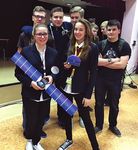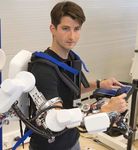The Space Foundation Report. The Authoritative Guide To Global Space Activity 2015.
←
→
Page content transcription
If your browser does not render page correctly, please read the page content below
Table of Contents
Overview..................................................................................................................................................................... 1
1.0 | Space Products and Services ................................................................................................................. 4
1.0 Introduction.............................................................................................................................................. 5
1.1 The Benefits of Space Products and Services...................................................................................... 5
1.2 Collaboration Between Space Agencies and the Public.................................................................. 12
2 0 1 5 2.0 | The Space Economy.................................................................................................................................. 13
2.0 Introduction............................................................................................................................................ 14
THE AUTHORITATIVE GUIDE
2.1 Commercial Infrastructure and Support Industries...................................................................... 14
TO GLOBAL SPACE ACTIVITY 2.2 Commercial Space Products and Services........................................................................................ 18
2.3 Government Space Budgets................................................................................................................. 22
2.4 Summary of Data................................................................................................................................... 38
Copyright © 2015
Space Foundation
A Snapshot: The Global Space Economy in 2014................................................................................... 40
All rights reserved. Printed in 3.0 | Space Infrastructure............................................................................................................................... 41
the United States of America.
3.0 Introduction............................................................................................................................................ 42
No part of this book may be
reproduced in any manner 3.1 Orbital Human Spaceflight Systems.................................................................................................. 42
whatsoever without written 3.2 Launch Vehicles...................................................................................................................................... 44
permission except in the case of
brief quotations embodied in 3.3 Space Stations.......................................................................................................................................... 49
critical articles and reviews. 3.4 Satellites.................................................................................................................................................... 50
For more information, 3.5 Spaceports................................................................................................................................................. 60
please contact:
4.0 | Workforce.................................................................................................................................................... 63
Space Foundation
4425 Arrowswest Drive 4.0 Introduction............................................................................................................................................ 64
Colorado Springs, CO 80907 4.1 U.S. Space Workforce............................................................................................................................. 64
1655 N. Fort Myer Drive, 4.2 European Space Workforce.................................................................................................................. 71
Suite 910 4.3 Japanese Space Workforce.................................................................................................................... 72
Arlington, VA 22209
4.4 Other Space Employment.................................................................................................................... 73
www.SpaceFoundation.org
Authors and Contributors......................................................................................................................................... 74
All images used in this
publication are property of
Endnotes........................................................................................................................................................................ 75
their respective owners. Index of Exhibits.......................................................................................................................................................... 81
Sign up for an online subscription at www.TheSpaceReport.org to read
updates, download the data behind the charts in this report, and much more!
A view of the Milky In an ESA telerobotics Even seasoned NASA Astronauts and Polish high school Radar Technologies Parents and children
Way Galaxy’s magnetic lab, André Schiele Administrator Charles cosmonauts pose students show off International’s use learn to remotely drive
field along the galactic demonstrates remote Bolden gets excited for a photo in the space models during a of GPS, Landsat rovers in the Space
plane. ESA’s Planck robotic operations during NASA’s test of International Space video teleconference imagery, Spaceborne Foundation’s Mars Yard,
satellite provided the with a lightweight the Orion spacecraft in Station. Koichi with the Rosetta Imaging Radar, a simulated Martian
image, which shows exoskeleton. The December 2014. The Wakata, in the Program’s project and Shuttle Radar landscape with various
how the magnetic exoskeleton allows an Orion is designed to center-bottom of the manager. The Rosetta Topography Mission challenging surfaces for
field interacts with operator to control a eventually transport circle, was the first spacecraft travelled technology enabled rovers to drive through.
interstellar gas clouds robot over a cellphone humans to Mars and Japanese astronaut billions of kilometers the company to find The Mars Yard resides in
and dust. Darker network. Credit: ESA other interesting Solar to assume space to rendezvous with a trillions of gallons the Space Foundation’s
colors represent higher System locations. station command. comet and land a small of water beneath Discovery Center in
concentrations of dust. Credit: NASA Credit: NASA probe on it in 2014. drought-ridden Colorado Springs,
Credit: ESA Credit: NASA/JPL Kenya. Credit: NASA Colorado. Credit: Space
FoundationOverview
Introduction | After years of steady, respectable growth, the space industry appears to be on
the cusp of a new era of rapid expansion in both capabilities and customers. Startup companies are
experimenting with novel approaches for building and deploying constellations of spacecraft and
delivering services to their customers in new ways. Long-established space operators are refreshing their
offerings as well, taking advantage of the latest technology to offer increasingly powerful products at
more affordable prices.
The global reach of satellites, which has long been one of the space industry’s defining characteristics,
is attracting interest and investment from other industries, particularly those whose continued growth
may depend on connecting the billions of people on the planet who currently are without access to
modern communications. For those customers who are already a part of the modern, networked
world, there is the prospect of seeing that world in a new way as several space companies vie to provide
transportation into space and a new view of the world in which we live. The way we go about our
daily lives is going to undergo many changes in
EXHIBIT 1. Global Space Activity, 2014
next several years, and the skilled professionals who
$36.21 B Commercial Infrastructure constitute the space industry are poised to take a
and Support Industries
(11%)
Commercial Space Products
leading role in making those changes a reality.
and Services
$42.96 B
(13%) $127.65 B
(39%)
U.S. Government Space
Budgets 1.0 | Space Products and Services
People recognize the benefits of space products and
Non-U.S. Government
services, using creativity to overcome daily existential
Space Budgets
$123.18 B challenges and improve lives. The space products and
(37%)
services industry crosses the spectrum of demands and
necessities, and continued to grow in 2014, sometimes
leveraging the same kind of technology to help with
Total: $330.00 Billion © Space Foundation different challenges. Space technology benefitting skiers in
the backcountry also saved crews from deadly scenarios at
sea. Neurosurgery, the smallest and finest of surgeries, applied technologies initially developed for manipulating large
objects around a space station. But perhaps the biggest impact of the space industry was in the form of tool that many
of us carry around each day.
Billions of people use satellite-augmented devices in their lives, whether the cheapest tablet or the most upscale
smartphone. More often than not, the processors within those devices have a satellite position, navigation, and timing
(PNT) function embedded within. In less than eight years since the smartphone’s introduction, more people than
ever use application services on mobile computers to hail and track a ride; find the closest, cheapest, and tastiest food
offerings; conduct banking securely; learn about a city’s history, while being guided to prominent tourist sites; and
more. None would be as convenient, accurate, or secure without satellite PNT integrated in each device.
Satellite-provided imagery became more affordable in 2014 and nearly ubiquitous on every mobile device.
Manufacturers included imagery applications on their devices in the form of map and navigation software. Combined
with a device’s PNT function, a person could order an updated image of their location. Other users received updated
imagery of disaster areas to see if relatives were safe. Combining imagery with PNT and communications networks
yielded real-time traffic updates for the drive home, updated delivery estimates of when a gift would arrive for a loved
one, or real-time weather conditions in tornado-prone regions.
1 The Space Report 2015 | The Authoritative Guide to Global Space ActivityOverview
These, and other space products and services, depend on data coming from fleets of satellites, operated by
governments and commercial entities. Many entrepreneurs and other talented individuals sought to provide
more data and products in unique ways, stimulating more growth in the growing space economy.
2.0 | The Space Economy
The year 2014 was a good one for the global space economy overall. Consisting of launch and ground services,
satellite manufacturing, satellite television and communications, government exploration, military spending,
and other interests, the global space economy grew by 9% in 2014, reaching a total of $330 billion worldwide.
Together, commercial space activities made up 76% of the global space economy and grew 9.7% in 2014. The
remainder was composed of government investments in space, which experienced a combined growth of 7.3%
in 2014.
U.S. government and military space budgets in aggregate comprised about 54% of space spending by all world
governments in 2014. NASA’s budget, which grew 4.6% over the 2013 budget, was 22% of what governments
around the world invested in space in 2014. Non-U.S. government space spending grew 12.9%, outpacing space
investment growth in the United States, as nations invested in new capabilities or expanded existing ones.
Revenue from commercial space products and services, which constituted more than a third of the global space
economy, grew modestly—slightly less than 2.5%. Direct-to-home television services dominate this sector,
making up more than three-quarters of the global commercial space products and services market in 2014.
The biggest growth in 2014 occurred in the commercial infrastructure and support industries sector, which
also constitutes more than a third of overall global space revenues. Industries such as launch, ground stations
and equipment, and satellite manufacturing were some of the mainstays that helped increase commercial
infrastructure and support industry revenues nearly 18% in 2014. High-value military satellite launches
decreased, but the number of launches conducted in 2014 increased significantly, rising to levels not seen in more
than a decade.
3.0 | Space Infrastructure
Space infrastructure is associated with launch vehicles, satellite operations and services, human spaceflight, and
other critical functions. Rocket launch attempts, the most publicly visible reminder of space activity, increased
in 2014 to 92, up from 81 launch attempts in 2013. The United States and Russia conducted the majority of the
launch attempts in 2014, but organizations and countries such as the European Space Agency, China, India,
and Japan also successfully launched payloads into orbit. New launch systems continued to be explored in 2014,
with one company testing space launch vehicle reusability as a possible way to lower the costs of launch objects
into orbit. Other companies focused on suborbital rocket flight, hoping to entice potential passengers into an
adventure to the edge of space and back.
The nature and size of rocket payloads, the satellites, are changing. Of the nearly 300 satellites launched in 2014,
slightly less than half weighed 10 kilograms (22 pounds) or less. In 2014, a single Russian space launch vehicle
launched and deployed a combination of 33 small satellites and cubesats into low Earth orbit. Some of those
deployed satellites eventually deployed more satellites into orbit as well. The size and commonality of parts in
cubesats is increasingly attracting researchers, small companies, and schools to invest, build, launch, and operate
satellites in space. The International Space Station started to become a launch platform itself, deploying small
satellites into orbit.
2 The Space Report 2015 | The Authoritative Guide to Global Space ActivityOverview
Although the United States spends the most money in space-related activities and industries, it does not currently
have its own human-rated space transportation system, instead choosing to buy passage to space from Russia. The
U.S. government, in partnership with industry, continued to make progress during 2014 to eventually change this
situation. If all goes well, one of NASA’s programs may provide U.S. astronauts direct access to space again by 2017.
While NASA will likely continue using established spaceports, other organizations made plans to build, kept
building, or finished new spaceports in 2014. One U.S. company broke ground for a new spaceport near
Brownsville, Texas, and China was rumored to have completed a new launch site. The Russians continued to build
launch facilities in Siberia, hoping to reduce dependence on launch facilities in Kazakhstan. But Russia still wrestles
with the question of how to entice a skilled workforce to Siberia to support the new spaceport’s activities.
4.0 | Workforce
A nation’s space workforce reflects its national priorities. Each spacefaring country’s workforce contains a mix of
age, education level, and gender. For 2014, the United States had a civil space workforce that continued to skew
older while getting smaller. Japan’s space workforce decreased slightly in 2014 after four consecutive years of
growth. European countries continued to foster growth in ESA and the European space industry workforce. In
most countries, the space industry is male-dominated, particularly in technical fields, although efforts are being
made in many places to increase the number of women in the workforce. The reasons for all these employment
fluctuations vary among countries as each makes policy and budget decisions affecting direction and leadership in
an increasingly competitive and productive industry.
An invitation from the Space Foundation
Over the course of the past decade, the Space Foundation research team has gathered an ever-expanding collection
of information about the space industry, government policies and priorities, and the evolving trends that influence
space activity. Each year, we present the highlights in The Space Report, focusing on the points that we believe are
of greatest interest to a broad audience. Beginning in 2015, the Space Foundation is offering an online service that
will provide subscribers with access to all the research conducted for The Space Report throughout its existence, as
well as new data sets that have never appeared in the report. We hope that this will become an even more valuable
resource for the space community, and we look forward to expanding the types of data we offer in response to
requests from our readers. To view more information about this new service, please visit www.TheSpaceReport.org.
This Hubble Space
Telescope image shows
the most massive
cluster of galaxies
ever detected, roughly
3,000 times the mass
of our own galaxy. The
blue overlay shows the
distribution of dark
matter, which has to be
inferred from the way it
bends light coming from
more distant galaxies
because the dark matter
itself is not visible.
Credit: NASA, ESA
3 The Space Report 2015 | The Authoritative Guide to Global Space ActivityIndex of Exhibits
Overview 45 EXHIBIT 3e. U.S. Orbital Launches, 2014
1 EXHIBIT 1. Global Space Activity, 2014 46 EXHIBIT 3f. Russian Orbital Launches, 2014
46 EXHIBIT 3g. Chinese Orbital Launches, 2014
1.0 | Space Products and Services 47 EXHIBIT 3h. Other Orbital Launches, 2014
5 EXHIBIT 1a. Topics Covered in Space Products and Services 49 EXHIBIT 3i. Spacecraft Mass Delivered by Market, 1995–2014
49 EXHIBIT 3j. Number and Mass of Spacecraft Launched by
2.0 | The Space Economy Market, 2014
14 EXHIBIT 2a. Topics Covered in The Space Economy 50 EXHIBIT 3k. Mass Launched by Intended Orbit, 1995–2014
14 EXHIBIT 2b. The Global Space Economy 50 EXHIBIT 3l. Spacecraft Mass Delivered by Manufacturer
Country, 1995–2014
14 EXHIBIT 2c. Global Space Activity, 2014
51 EXHIBIT 3m. Number and Mass of Spacecraft Launched by
14 EXHIBIT 2d. Revenues for Space Infrastructure, 2014
Mission, 2014
15 EXHIBIT 2e. Orbital Launch Attempts, 2014
51 EXHIBIT 3n. Number and Mass of Spacecraft Launched by
15 EXHIBIT 2f. Launch Services Value by Market, 2012–2014 Prime Manufacturer Country, 2014
15 EXHIBIT 2g. Spacecraft Value by Market, 2012–2014 51 EXHIBIT 3o. Geosynchronous Communications Capacity
16 EXHIBIT 2h. Spacecraft Value by Manufacturing Country, Launched Per Year and Per Band, 1995–2014
2012–2014 52 EXHIBIT 3p. Total Available Geosynchronous Communications
16 EXHIBIT 2i. NASA Commercial Crew Funding Capacity Per Year and Per Band, 2000–2014
18 EXHIBIT 2j. Space Insurance Industry Estimates, 1994–2014 52 EXHIBIT 3q. Total Available Geosynchronous High Throughput
18 EXHIBIT 2k. Revenues for Commercial Space Products and Satellite Capacity per Year and Per Band, 2004–2014
Services, 2014 52 EXHIBIT 3r. Civil Government and Commercial Satellite
19 EXHIBIT 2l. North American Direct-to-Home Television Communications Contracts By Contractor Country, 2000–2014
Revenue, 2014 53 EXHIBIT 3s. Positioning, Navigation, and Timing Systems,
21 EXHIBIT 2m. Earth Observation Revenue Estimates, December 2014
2007–2013 61 EXHIBIT 3t. Spaceports in Operation or Development, 2014
22 EXHIBIT 2n. Government Space Budgets, 2014
22 EXHIBIT 2o. Government Space Budget Growth, 2012–2014 4.0 | Workforce
23 EXHIBIT 2p. U.S. Government Agency Space Budgets, 2014 64 EXHIBIT 4a. Topics Covered in Workforce
23 EXHIBIT 2q. NASA Fiscal Year 2016 Budget Request 64 EXHIBIT 4b. Space Workforce Trends in the United States,
24 EXHIBIT 2r. Funding for Major U.S. National Security Space Europe, and Japan
Programs, Fiscal Years 2011–2015 65 EXHIBIT 4c. U.S. Space Industry Employment by Sector, 2003,
26 EXHIBIT 2s. Canadian Space Agency Spending Profile by 2008, 2012, and 2013
Program Activity 65 EXHIBIT 4d. U.S. Space Industry Core Employment, 2003–2014
27 EXHIBIT 2t. Space Spending as a Percentage of Gross Domestic 65 EXHIBIT 4e. U.S. Space Industry Employment and U.S. Total
Product (GDP), Selected Countries Employment, 2003–2014
28 EXHIBIT 2u. European Commission Budget for H2020/Space, 66 EXHIBIT 4f. U.S. Space Industry Salaries and Real Salary Growth
2014–2015 by Sector, 2008–2013
28 EXHIBIT 2v. ESA Member Contributions to 2014 Budget 67 EXHIBIT 4g. NASA Civil Servant Workforce, FY 2005–2015
29 EXHIBIT 2w. ESA’s 2014 Budget by Program and Funding Source 68 EXHIBIT 4h. NASA Civil Servant Workforce Age Profiles Over
30 EXHIBIT 2x. CNES Planned Spending by Program Area, 2014 Time
33 EXHIBIT 2y. Indian Space Budgets 68 EXHIBIT 4i. NASA Civil Servant Workforce Demographics, Start
34 EXHIBIT 2z. Japanese Space Spending by Agency, 2014 of FY 2015
36 EXHIBIT 2aa. Republic of Korea Government Agency Work on 69 EXHIBIT 4j. U.S. Air Force Space Workforce, FY 2004–FY 2014
Satellite Applications, 2014 69 EXHIBIT 4k. U.S. Air Force Space Workforce Demographics,
37 EXHIBIT 2bb. South Korean Government Institutions Working FY 2014
with Satellite Imagery Applications, 2014 71 EXHIBIT 4l. U.S. Space-Related Occupations and Projected
38 EXHIBIT 2cc. Space Budgets of Selected Additional Countries, Growth Rates
2014 71 EXHIBIT 4m. European Space Industry Employment, 2003–2013
39 EXHIBIT 2dd. Summary of Global Space Activity Revenues and 71 EXHIBIT 4n. European Space Industry Employment by Country,
Budgets, 2012–2014 2008–2013
72 EXHIBIT 4o. European Space Workforce Demographics, 2013
3.0 | Space Infrastructure 72 EXHIBIT 4p. ESA Workforce Demographics, 2014
42 EXHIBIT 3a. Topics Covered in Space Infrastructure 72 EXHIBIT 4q. Japanese Space Industry Employment, 2003–2013
43 EXHIBIT 3b. Number of Launches Attempted and Payload Mass 72 EXHIBIT 4r. Japanese Space Industry Employment by Sector,
Aboard Attempted Launches, 1983-2014 2008–2013
43 EXHIBIT 3c. Geosynchronous (GSO) and Non-geosynchronous 72 EXHIBIT 4s. JAXA Workforce, 2004–2014
(NGSO) Historical Commercial Launches and Launch Forecast, 72 EXHIBIT 4t. JAXA Workforce Demographics, 2014
2015 73 EXHIBIT 4u. Space Agency Employment for Selected Countries,
44 EXHIBIT 3d. Commercial Satellite and Launch Forecasts, 2014
2016–2024
81 The Space Report 2015 | The Authoritative Guide to Global Space Activitywww.SpaceFoundation.org
TO ADVANCE SPACE-RELATED
ENDEAVORS
TO INSPIRE, ENABLE, AND
PROPEL HUMANITY.
World Headquarters and Discovery Center Washington Office
4425 Arrowswest Drive 1655 N. Fort Myer Drive, Suite 910
Colorado Springs, CO 80907 Arlington, VA 22209
+1.719.576.8000 +1.202.618.3060You can also read



























































